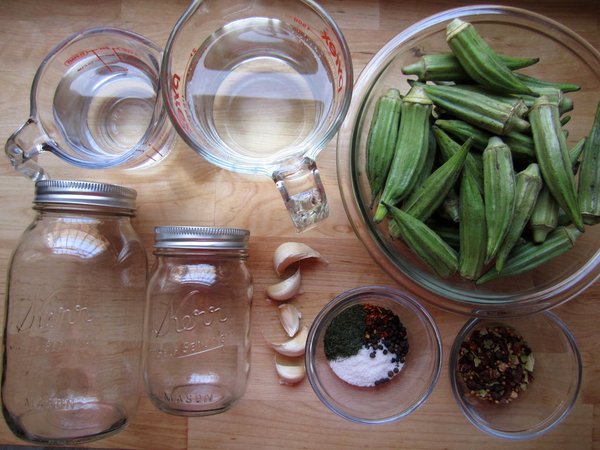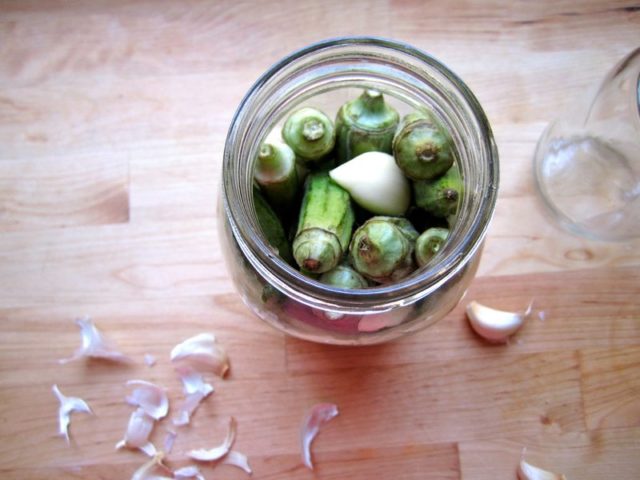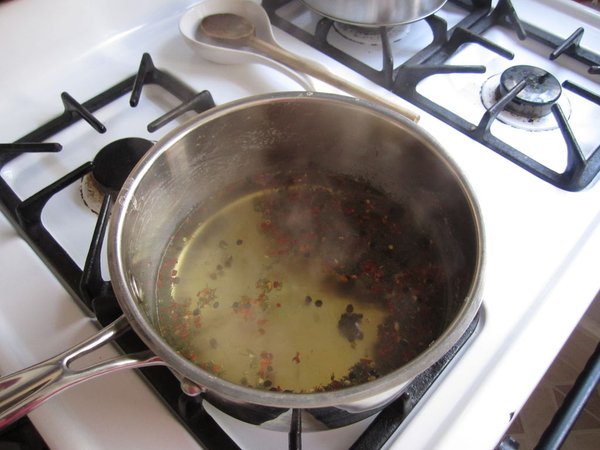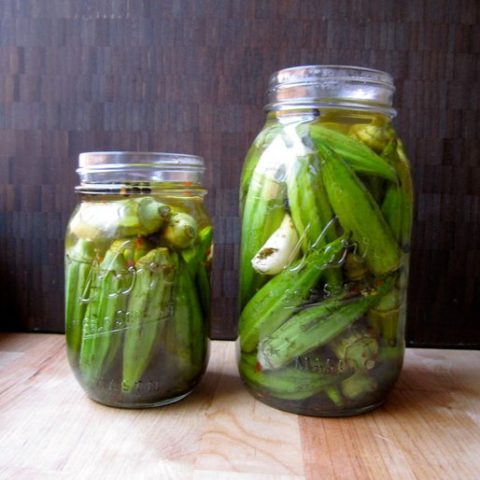Content
Pickled okra is found in many salads and is also used as a savory snack. Some people hear about this unfamiliar vegetable for the first time. Okra (second name) is often used in vegetarian cuisine and in the southern regions of the country, where it grows. Fresh okra deteriorates quickly. But there is an ideal solution: when the product is purchased, preserve all the beneficial properties and add spice with the help of preservation.
The benefits of pickled okra
The popularity of "ladies' fingers" has brought its composition and taste, reminiscent of something between asparagus and eggplant. Canned okra, in addition to its rich vitamin composition, fiber and minerals, contains folic acid, which is necessary for pregnant women and to stimulate recovery processes.
Useful properties of okra pickled in different ways:
- It is included in the diet menu due to its low calorie content. 100 g of the product contains only 30 kcal.
- It removes toxins, excess cholesterol from the body, has a choleretic effect.
- Regular use of pickled okra will help develop joints and strengthen blood vessels.
- Strengthens the nervous system.
- In America, okra is the leading cancer-fighting drug. The product has a high content of glutathione, which fights free radicals and suppresses the effect of carcinogenic substances on cell DNA.
Of course, this is not the whole characteristic of pickled healthy okra, which practically has no special contraindications, except for allergic rashes and individual intolerance.
Cooking features
You will need to select okra first. Chefs advise young, or even unripe, fruits for pickling, no less than 5 cm and no more than 10 cm in size. The fact is that the "old" fruit does not have pronounced taste and is rather tough.
Before preparing delicious pickled okra, rinse the pods well under the tap and remove fine hairs from the surface. The heat treatment process is short-lived, because okra can simply fall apart. The pods must be processed within 24 hours.
The following varieties of okra are more suitable for canning:
- Sultaniye;
- Tsarigradskaya;
- Kavaklian.
The experience can be unsuccessful if all the rules have not been followed.
You can serve the marinated product as an appetizer, as part of salads or as a side dish for meat dishes.
Ingredients
The recipe is the simplest and will not take much time.
For pickling, you will need the following products:
- okra - 1 kg;
- garlic - 10 cloves;
- vinegar (essence) - 4 tsp;
- water –2 tbsp;
- dill - 2 tbsp. l .;
- salt (preferably sea salt) - 4 tbsp. l .;
- chili pepper - 2 pods;
- black peppercorns - 2 tsp;
- cloves - 10 pcs.
You can play with the ingredients if, after a trial canning, you are still dissatisfied. For example, add or reduce the amount of pepper during pickling. Use table vinegar, white wine instead of essence, the main thing is that there is enough of it. It is he who will give a crunch to the finished product.
There are also options when people do not like food that is too spicy. Then you can take only one pod of hot pepper or replace with mustard seeds. Add granulated sugar preservative. Some people simply prefer to buy pre-packaged pickling seasoning mixes.
Pickled okra recipe
Step-by-step photos that are attached to the cooking instructions will help to properly preserve the okra:
- For okra pickled in any way, rinse the jars thoroughly under the tap with soapy soda solution. It is imperative to sterilize over steam for at least 10 minutes each and set aside, an abscess on the neck with a kitchen towel so that dirt does not get into.
- Wash the okra thoroughly and cut off the tail, but not to the seeds. Sprinkle with citric acid and rub. Leave it on for a couple of hours so that it loses its slippery coating. This will make the color lighter. Rinse again, wipe off and place in prepared glass containers. Peel the garlic and distribute to jars. If it is very large, cut it.
- Remove the stalk with seeds from hot peppers. Rinse under the tap and chop. Send along with dill, black peppercorns, salt and cloves in a saucepan to the fire, pouring water. As soon as the composition boils, turn off and add the vinegar essence. Mix.
- Pour the hot marinade evenly into the jars, controlling the spices in each. The liquid should completely cover the okra.
- Leave for an hour so that the composition is infused without lids. Can be covered with napkins. When the temperature equals room temperature, tighten the caps. Transfer to a cool place first, and then refrigerate.
Canned okra gains flavor over time. Therefore, it is not recommended to use it immediately. It is better to let the jars brew for about a month.
Terms and conditions of storage
The shelf life of pickled okra and conditions depend on the ingredients in the composition, the method of canning.
Here is some of them:
- When using the classic method of preparing pickled okra with a sufficient amount of preservatives and tightly screwing tin lids, cans can stand from 0 to 25 degrees in a dark place for almost 3 years, if there are no large temperature differences.
- Put pickled okra in the refrigerator when using additional vegetables. These can often be: carrots, tomatoes, eggplants and bell peppers. This is especially true if a nylon cover is used, which allows oxygen and microbes to pass through. Then the storage conditions will change. Banks will need to be placed in a refrigerator or cellar, where temperatures are low.
- An opened jar of pickled okra should stand in a cold place for no more than 3 days.
If initially dirt got into the container with pickled okra, and the quality of the preservative and products made much to be desired, the jars may become cloudy. Eating them is dangerous to health.
Conclusion
Pickled okra is practically the only way, besides freezing, that allows you to preserve a healthy product for the entire cold season. It is worth stocking up for future use to prepare delicious meals in winter.














